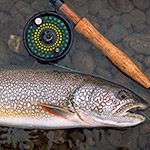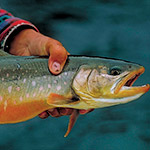Aside from salmon, there are two other general groupings of fish that are actively targeted in Alaska’s roadside waters. These are trout, which include the resident and sea-run forms known as rainbow and steelhead, followed by char, such as Dolly Varden, arctic char, and lake trout. Their numbers and distribution – as well as physical size – are highly variable dependant on location but generally thought of as being abundant throughout the Southcentral region.
Steelhead Trout
 Common Name: Rainbow, Trout
Common Name: Rainbow, Trout
General Timing: April and May; August to November
Typical Size: 5 to 12 pounds, up to 18 pounds
State Record: 42 pounds, 3 ounces
Best Areas: Rivers and streams
Preferred Methods: Spin-casting and fly-fishing
Standard Gear: Medium rod/reel; 8- to 14-lb test
Top Tackle: Spoons, spinners, plugs, and flies
Steelhead trout have a very limited range of distribution along the road system in Southcentral Alaska compared to other areas of the state, present only in a half-dozen streams. While angling success is only mediocre on average, when finally hooked the steelhead puts on a show that is worthy of pursuit under the most stringent water and weather conditions.
There is a limited spring fishery for steelhead, usually coinciding with the early run of king salmon, yet it is the fall opportunities that really make this species shine. The months of September and October have traditionally been the best time to be on the water as the fish are bright and strong and fresh out of the sea, but steelheading can be productive all the way through fall up to freezeup.
The only fishable drainages on the continuous road system are the lower Kenai Peninsula streams, notably the Kasilof, Ninilchik, and Anchor rivers and Deep Creek. Some fish are also present in Stariski Creek. A smaller run occurs in the Gulkana River in Copper Valley.
Steelhead are not regarded as a food item and regional regulations currently prohibited anglers from killing these fish in majority of waters.
Rainbow Trout
 Common Name: Trout
Common Name: Trout
General Timing: April to December
Typical Size: 10 to 22 inches, up to 20 pounds
State Record: 42 pounds, 3 ounces*
Best Areas: Rivers, streams, and lakes
Preferred Methods: Spin-casting and fly-fishing
Standard Gear: Light/ultra light rod/reel; 4- to 10-lb test
Top Tackle: Spoons, spinners, plugs, flies, and bait
Rainbow trout are widely distributed throughout Alaska and may be found in most roadside lakes and streams. It is a superb game fish and one of the most sought-after species among anglers due to their intense temperament when hooked, unmatched by any other fish of similar size.
Although normally associated with the spring and fall fisheries, good action can be had virtually all season long and extending into the early winter months as well. Where allowed, May and June can be hot but many areas are closed to trout fishing during the spring spawning period. The months of August, September, and October are synonymous with exceptional trouting as food sources are abundant and fish engage in a feeding frenzy preparing for the long winter ahead.
Clearwater tributaries of the Susitna River drainage in the Susitna Valley and the mainstem Kenai River and associated streams on the Kenai Peninsula have long been regarded as the top wild trout populations along the road system. Copper Valley has far fewer trout waters but exceptional action still possible in spots with near complete solitude.
Artificial stocks (hatchery fish) are widespread and present especially in lakes and ponds around major towns and cities.
* The state record was specifically a sea-run rainbow trout, better known as steelhead.
Lake Trout
 Common Name: Char and Trout
Common Name: Char and Trout
General Timing: September to June
Typical Size: 4 to 12 pounds, up to 25 pounds
State Record: 47 pounds, 0 ounces
Best Area: Lakes
Preferred Methods: Spin/bait-casting and fly-fishing
Standard Gear: Light/medium rod/reel; 8- to 15-lb test
Top Tackle: Spoons, spinners, plugs, jigs, flies, and bait
Contrary to its common name, lake trout are not actually trout at all but a species of char. They thrive in large, deep, and cold inland lakes and when hooked put up a valiant battle. They are targeted by local anglers early and late in the season but may smaller specimens may be found in fishable numbers even throughout the summer months.
Dolly Varden
 Common Name: Char and Trout
Common Name: Char and Trout
General Timing: May to December
Typical Size: 10 to 20 inches, up to 10 pounds
State Record: 27 pounds, 6 ounces
Best Areas: Rivers, streams, lakes, and saltwater
Preferred Methods: Spin-casting and fly-fishing
Standard Gear: Light/ultra light rod/reel; 4- to 8-lb test
Top Tackle: Spoons, spinners, plugs, flies, and bait
Dolly Varden are numerous throughout Southcentral as well as the rest of the state, found in nearly every body of water ranging from mere trickles of creeks and beaver ponds to large glacial rivers and deep mountain lakes. Usually not a bit shy about striking artificial lures and flies, these char are a great game fish when other species fail.
Anglers can experience very productive Dolly Varden fishing all season long, from spring through fall in most rivers and streams, with worthwhile action continuing even into mid-winter in lakes. May and June are great for sea-run char while the freshwater fisheries pick up in July and stay strong through September and into October.
The majority of rivers and streams on the Kenai Peninsula support good populations of Dolly Varden with smaller – yet very productive – stocks also found in the Turnagain Arm area and the Matanuska, Susitna, and Copper valleys.
Sea-run populations are present all along the coast of Kenai Peninsula and Prince William Sound.
Dolly Varden do make a good meal, preferably right out of the stream fresh, but are not especially targeted as such given the presence of salmon and the fact that many fishers view these char of more value for catch-and-release sport instead of food.
Arctic Char
 Common Name: Char and Trout
Common Name: Char and Trout
General Timing: August to March
Typical Size: 12 to 25 inches, up to 15 pounds
State Record: 27 pounds, 6 ounces*
Best Area: Lakes
Preferred Methods: Spin/bait-casting and fly-fishing
Standard Gear: Light/ultra light rod/reel; 4- to 8-lb test
Top Tackle: Spoons, spinners, plugs, jigs, flies, and bait
Arctic char are very similar in appearance to Dolly Varden and when in feeding phase may be difficult to tell apart. It is not a common species despite a fairly wide distribution and at first may seem difficult to catch wherever found. However, with the right tackle and methods applied, char are an aggressive species that put up a noteworthy fight.
* Alaska does not differentiate between Dolly Varden and Arctic char regarding state/trophy records; indicated species was specifically a sea-run Dolly Varden.


